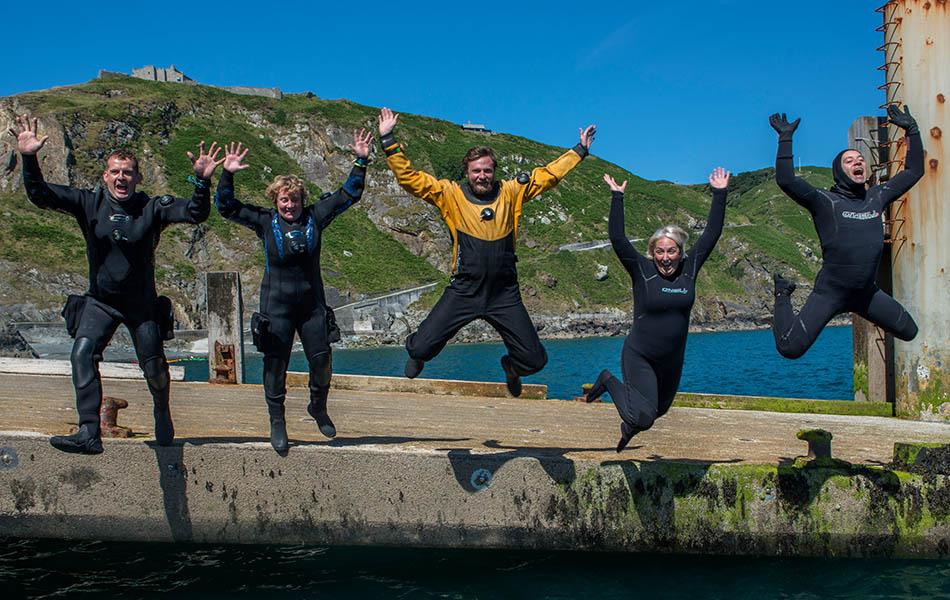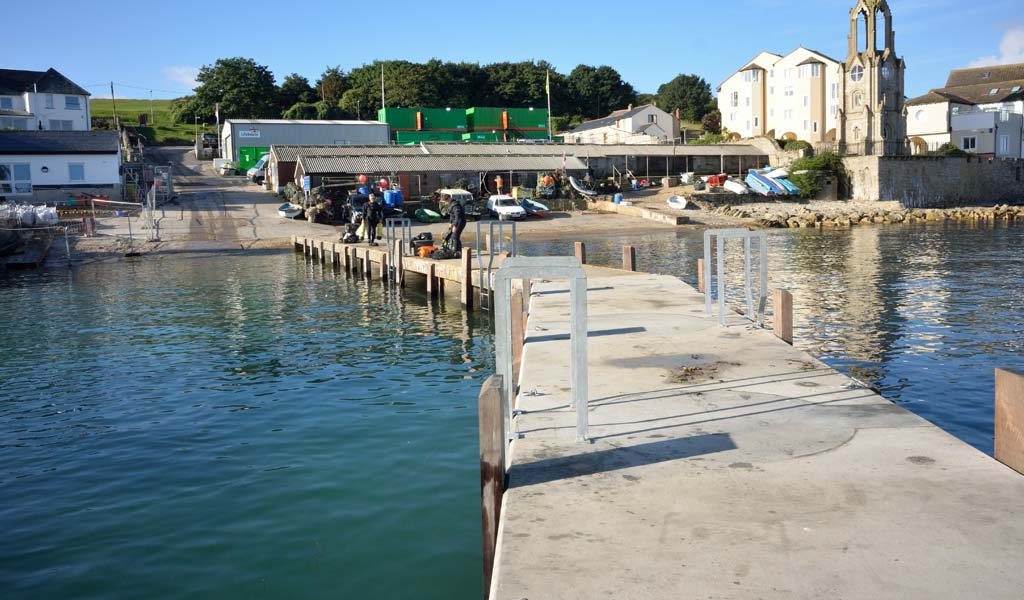
Anita Sherwood of Worcester Divers explores the classic dives around Dorset resort town of Swanage.
Kyarra
This luxury passenger liner, which became a casualty-clearing ship in 1917, was on her way to Plymouth, fully loaded with a mixed cargo of goods, to collect 1,000 wounded Australian soldiers and repatriate them. As she passed the Isle of Wight, she was spotted by Oberleutnant Johann Lohs aboard the German submarine UB-57. The ship took a direct torpedo hit to the port side, amidships, and sank quickly with six of the crew losing their lives.
The Kyarra is an impressive wreck and something of a national Mecca among the diving fraternity. Part of the attraction has always been the chance of finding treasure, with pocket watches, perfume bottles and various paraphernalia uncovered on the wreck. Today the ship has been so heavily dived that collectables are less likely to be found, but there is still plenty to see. The Kyarra usually has permanent buoys tied to it, which surface on slack water.
Due to the ship’s size, it’s wise to begin either at the stern or the bow and work your way along. Starting at the stern you’ll get a good impression of the scale of the ship by viewing the rudder, which at first you may not even notice. The clues are the gudgeon and pintle attachments to the rudder post. Just aft of here is the interesting detail of a pulley wheel with steering chain still wrapped around it. The Kyarra has fallen onto its starboard side, with many sections of broken railings and bollards along the top on the port side, taking the full brunt of the current.
The liner was fitted out with two triple-expansion engines, so if you wish to take a glimpse at one, keep to the port side. The engine has fallen starboard and bursts through the deck, revealing the humongous connecting rods and engine parts inside. Now weave your way down across the expansive metal plates studded with enticing holes to the starboard side to view the imposing boiler. There were actually four boilers on the ship, but only one has rolled clear of the debris. The fireboxes are at the top with the stay holes below, providing plenty of dwellings for cute-looking tompot blennies.
Behind this boiler is an appealing window-like passage with bent structural beams overhead, which is an ideal spot to hang around and watch the many silvery streams of bib. Just on from here, a jewel anemone encrusted mast lies on the sand at 90 degrees to the ship with plenty of evidence of the rigging. The next significant port of call is a huge anchor winch firmly attached to the deck. If you head around the base you can still see the chain heading through various pipes to the chain locker and the front of the bow. The slack window is always too short and by now the current will have picked up and it will be time to leave.
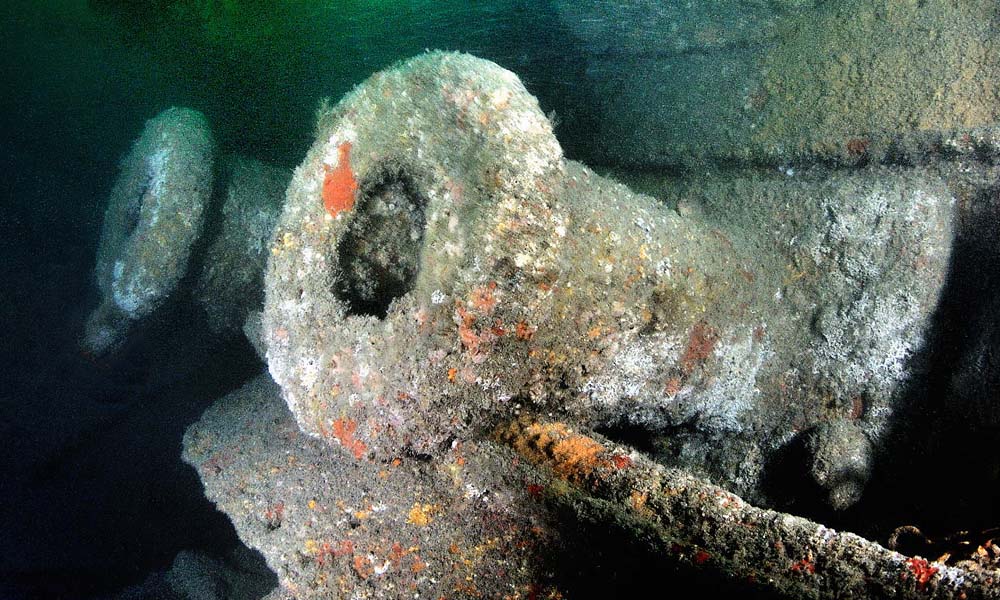
REEF ⬜ WRECK ☑️
GPS: 50°34.918N 001°56.635W (stern)
SLACK WATER: dive 1h 15min before or 5h 15min after high water at Dover (slack water only lasts 35 minutes on springs).
DISTANCE: 3km from Swanage
DEPTH: 29m
SIZE OF WRECK: 126m long
SANK: 26 May 1918
Betsy Anna
The collier Betsy Anna was on her way back to Rotterdam when she encountered thick fog skirting around Prawle Point. She ran ashore and became wedged into the rocks, but the crew was able to clamber off safely. She was then bought by a salvage company, and patched up to be towed to Cowes. Unfortunately, the wrong day was chosen for her journey and as gale-force winds closed in and the collier broke her tow and sank in Poole Bay.
This is a rough and rugged type of steamship with all the trimmings but without the serious undertaking of a deep dive. The ship is very spread out with islands of wreckage dispersed across the sandy seafloor. In poor viz it might be hard moving from one section of metal to the next but nothing is more than a few metres apart. From the boilers you can head north-north-east to the bow, first passing over flat metal plates to a cargo winch, then just forward of this is an anchor winch lying on its side. Continuing on, you’ll soon reach the bow, which is very broken up, with clear evidence of trawler netting over the metalwork. On closer inspection, you’ll see a hawse pipe with chain hanging out.
Retracing your path back to the boiler, you’ll see that the donkey boiler and main boiler stand in line with the ship, rising 2m and 4m high, respectively. Between them is a dark corridor where congers often lurk in fire holes either side. Behind the boilers is the heart of the ship; the triple-expansion engine, which has fallen over onto the port side. It’s worth having a good poke around here as you can see most of the engine’s workings. The piston rods are still attached to the cylinder heads and below this you can see the connecting rods leading down to the partly buried crankshaft. It is best to follow the prop shaft to the stern, which is the highest section of wreckage, rising a good 5m off the seabed. At this point, you’ll be fighting with the bib to see inside for a clear picture of the skeletal remains. The beams high above are studded with beautiful displays of jewel anemones. If you head outside and around you can clearly see the stern section has fallen almost upside down with a pair of sturdy bollards and deck railings hanging from above.
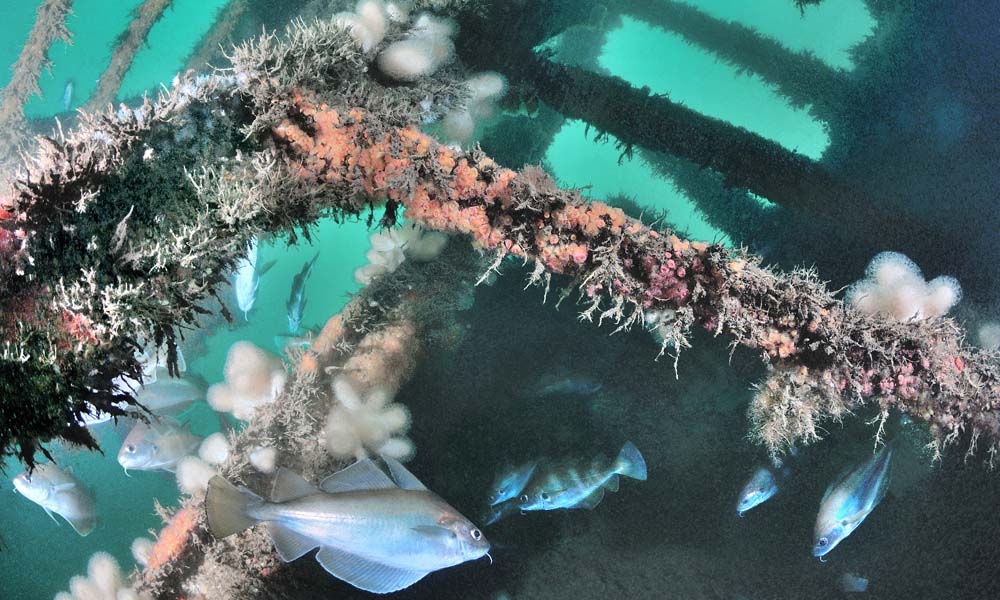
REEF ⬜ WRECK ☑️
GPS: 50°36.994N 001°48.971W
SLACK WATER: Dive 1h 15mins before or 5h 15min after high water at Dover.
DISTANCE: 9.3km from Swanage
DEPTH: approx 25m
SIZE OF WRECK: 62m long
SANK: 12 August 1926
Castlereagh
The wrecking of the steamship Castlereagh, locally known by her original name Firth Fisher, is a bit of mystery as no-one saw her sink. Her fateful passage to Shoreham in West Sussex was in rough seas and it is believed she became overwhelmed. Two bodies were later washed up on the Isle of Wight, and the wreck was discovered by a diver in 1967, close to the wreck of the Kyarra.
The Castlereagh is vastly different in character to its eminent neighbour, but nevertheless superb. A smaller steamship, she is a lot less challenging to explore with the added bonus of escaping the diving crowds. Dropping down over the stern is worth a quick mooch around. A pump lies on the seafloor, possibly fallen from the engine room. The prop shaft is in place but the propeller and rudder have been salvaged, with just one abandoned blade left on the seafloor.
The ship landed upright and is very contained, so from the stern deck on in you can stay within the confines of the hull until you reach the bow. As a cargo ship, the holds were all placed upfront so the engine is at the back. This was a double-expansion engine and today it stands in good condition, 6m high. A browse around the base of the engine with a good torch will reveal the inner workings. The engine and boiler were separated by a bulkhead, which has collapsed onto the boiler obscuring the aft slightly.
The top of the boiler remarkably still has a pressure release valve attached. After the bulkhead, you can swim along the holds. A large cargo winch and cable drum lie next to each other speckled with jewel anemones and sponges. Just in front of this is a strange-looking object, the remains of the helm. There is one more cargo winch to pass before you arrive at the bow. This has suffered damage, its top possibly ripped off by trawlers, leaving a debris trail scattered to the starboard side. Chain from the locker has spewed out over the hull, while the anchor winch has fallen totally clear and landed upside down. An anchor pokes up from the pile of debris although you’ll need a keen eye to spot it. The delight of this small steamship is that you should still have plenty of time to go back and explore further to check out the nooks and crannies for congers and lobsters.
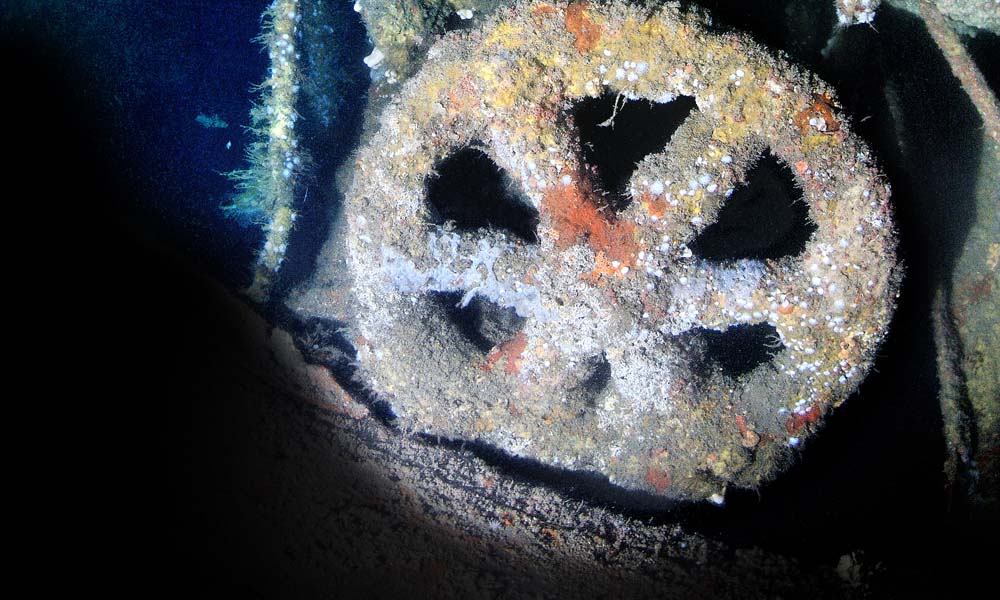
REEF ⬜ WRECK ☑️
GPS: 50°34.839N 001°56.177W
SLACK WATER: Dive 1h 15mins before or 5h 15min after high water at Dover.
DISTANCE: 3.5km from Swanage
DEPTH: approx 37m
SIZE OF WRECK: 51m long
SANK: 23 February 1925
Fleur de Lys
This inshore crabber was on its way back to Weymouth from the coast of Alderney, in the Channel Islands, when an explosion from a hot water cylinder occurred in the engine room. The four crew members grabbed their lifejackets but failed to inflate the life raft. Within 16 minutes a helicopter had arrived on the scene to rescue the crew, but by this time the Fleur had already sunk. Attempts to raise and tow the trawler to Poole were made in vain and she was eventually abandoned in Swanage Bay.
Today the fishing trawler is extremely popular as it is only a 2km boat ride from Swanage. This is a tiny wreck so in just 10 minutes you can easily circumnavigate the boat. The wreck is a vibrant metropolis of marine life, mostly juvenile fish with a dense shoal of small bib, small lobsters and you guessed it, small tompot blennies. At the time of writing, there was a permanent shot on the stern but be careful to keep a firm grip on the line as the surface current can be quite strong. At the stern is the four-bladed propeller and rudder half-buried in the sand, with the steering mechanism standing up a couple of metres. Working your way along the outside of the ship you’ll soon notice the crumbling oak timbers seized by marine growth that obscures the original blue and white paint. These planks are all fastened by nails to a metal frame and each year the wood deteriorates further to leave these distinctive long rusty nails projecting out along the sides of the hull.
Make sure your torch is fully charged as there are lots of interesting holes to investigate and you never know what you will find. Just underneath the bow, there are a couple of fascinating old glass fishing floats, although they are broken into a few pieces. The innards of the ship rise up a couple of metres, a mish-mash of broken wreckage from heating pipes to old rope. An unusual wooden tunnel-like structure stands upright amongst the debris, encircled by a young shoal of bib. Once you have finished here, you can drift off, with a delayed surface marker buoy deployed, and explore the low lying rocky reef.
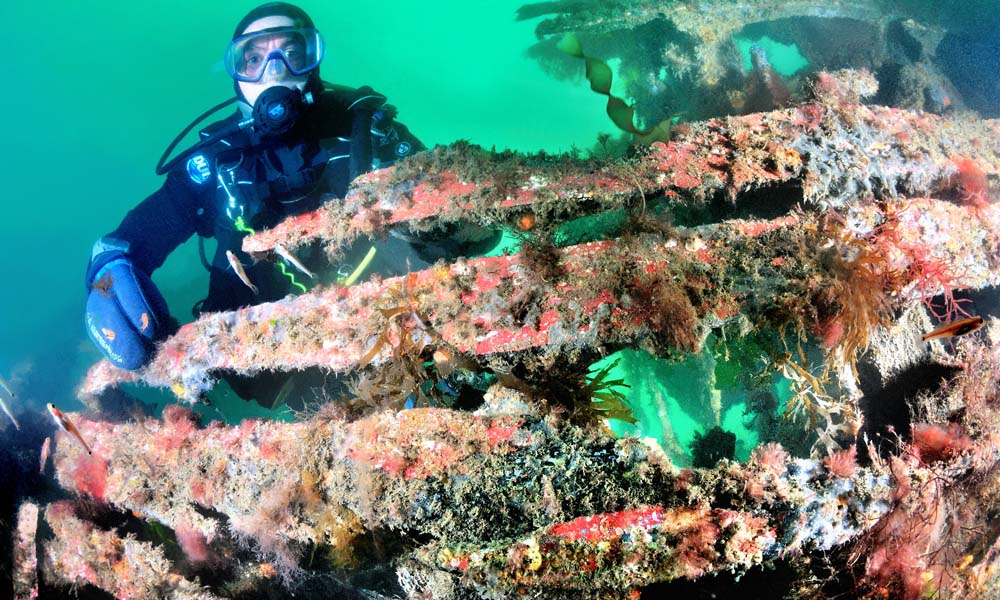
REEF ⬜ WRECK ☑️
GPS: 50°37.594N 001°56.135W
SLACK WATER: Dive at any state of tide but expect some current.
DISTANCE: 2km from Swanage
DEPTH: approx 13m
SIZE OF WRECK: 17m long
SANK: 16 April 2000
Anvil Point lighthouse
On a calm, sunny day Anvil point lighthouse cliffs make an ideal picturesque dive site for newly trained divers. It’s a crowd-pleaser, as above water the scenery is spectacular and below it’s an easy, relaxing dive. Unless you’re after a drift dive, stray no deeper than 10m and stay within the confines of the bay. Below the cliffs are huge boulders with passageways underneath where small wrasse shoot along. As you head out, the terrain quickly levels off to flat rocky ledges with crevices for the usual edible and velvet swimming crabs. I would class this dive as one for macro photographers or a lunchtime bimble, but not as a main dive. There’s little kelp, which is quite a surprise for a shallow site. The fish life is not abundant here but greater pipefish can sometimes be found. In summer small aggregations of sea hares cluster on the rocky ledges, forming chains on top of each other.
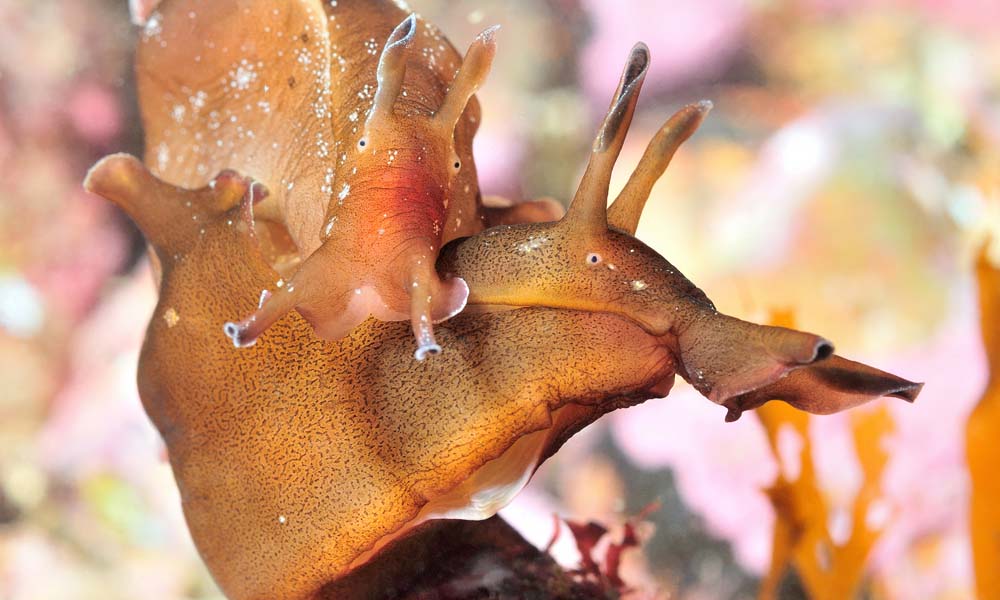
REEF ☑️ WRECK ⬜
GPS: 50°35.496 N 00 1°57.472W
SLACK WATER: Dive at any state of the tide, but expect current further away from the headland, where a drift dive is possible.
DISTANCE: 3km from Swanage
DEPTH: approx 10m
TERRAIN: boulders inshore to low-lying rock ledges further out
Peveril Ledges
Peveril Ledges is a stone’s throw from the harbour and is conveniently marked by a red channel marker buoy. The ledges offer a drift that’s fast enough for to get your adrenaline pumping: you can fly over sloped rocky ledges while not going on a white knuckle ride. The best time to dive is on a flooding tide. Once down it is very difficult to stop, so keep your eyes peeled as you cruise along. As this is a high energy area you’ll see the typical squidgy life covering almost the full spectrum of sponges from the carrot sponge to the more common yellow boring sponge. Lobsters can be spotted but there is no time to wait around their lairs. The one thing you’ll soon notice is how everything else apart from you can handle the current. Red gurnards seem perfectly adapted, having no trouble tip-toeing over the seabed against the flow. Edible crabs bury themselves in the sand and prawns hang around in the shelter of their caves.
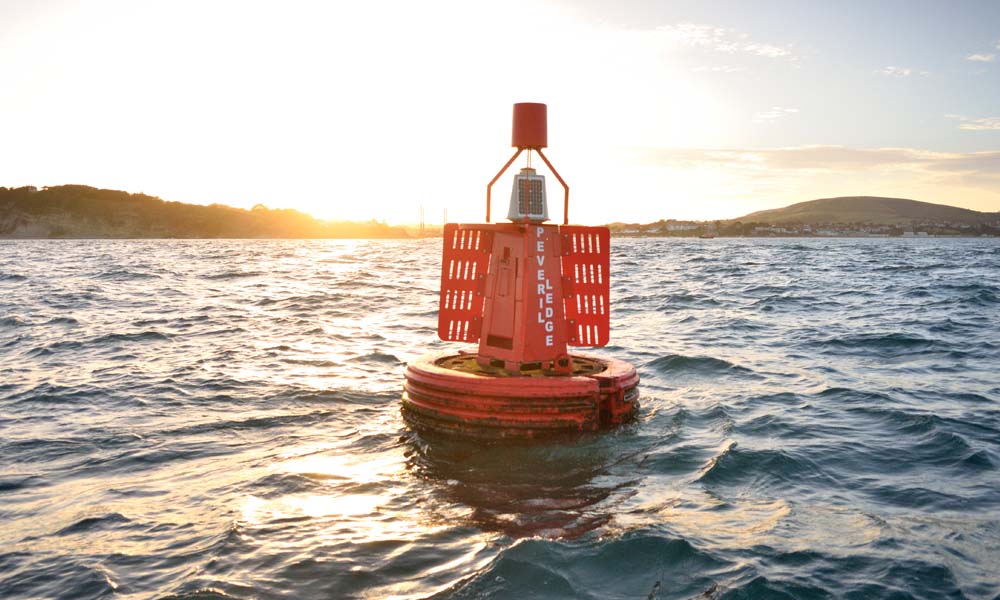
REEF ☑️ WRECK ⬜
GPS: 50°36.416N 001°56.095W
SLACK WATER: On a spring tide, dive 1h before or 5h after high water at Portsmouth, on neaps you can dive during the flood tide or on slack water.
DISTANCE: 1km from Swanage
DEPTH: 10-20m
TERRAIN: Sloped rocky ledges with maerl interspersed between the rocks
Valentine tanks
During the Second World War, a failed attempt to design amphibious tanks sent seven canvas wrapped prototypes to the bottom of Poole Bay. Only these two remain mostly intact as evidence of this tragic folly.
At the time of writing, the most intact Valentine tank had a permanent shot line on it with a rope trail at the bottom leading on to the next. The first tank is very distinctive, with caterpillar tracks on one side and the turret and part of the gun still remaining. This is a dive site that comes with minimum effort and yet offers maximum reward. It literally takes minutes to circumnavigate the two tanks. On this dive, you simply need to just stop and observe the live-action. On a barren flat seabed, these tanks have transformed into a marine safari park. The tanks are commanded by squadrons of bib, with tightly packed ranks of juveniles to adults. Congers have breached the rubber wheels peering out from within, they wait for that ideal moment to ambush their prey.
Also within these feeding grounds hide the elusive John Dory. They cleverly obscure themselves in the shoal, striking out at any stray juvenile bib. Remember to leave time to cross ‘no man’s land’ by following the rope west to the other tank, it will take about five minutes of finning over a seabed of slipper limpets and broken shells. The second tank is not in quite as good condition as the first: its turret has been fouled by fishing gear and now rests upturned with the gun half-buried. About a metre away is the rest of the tank. A similar story here, it is cloaked in dense shoals of bib.
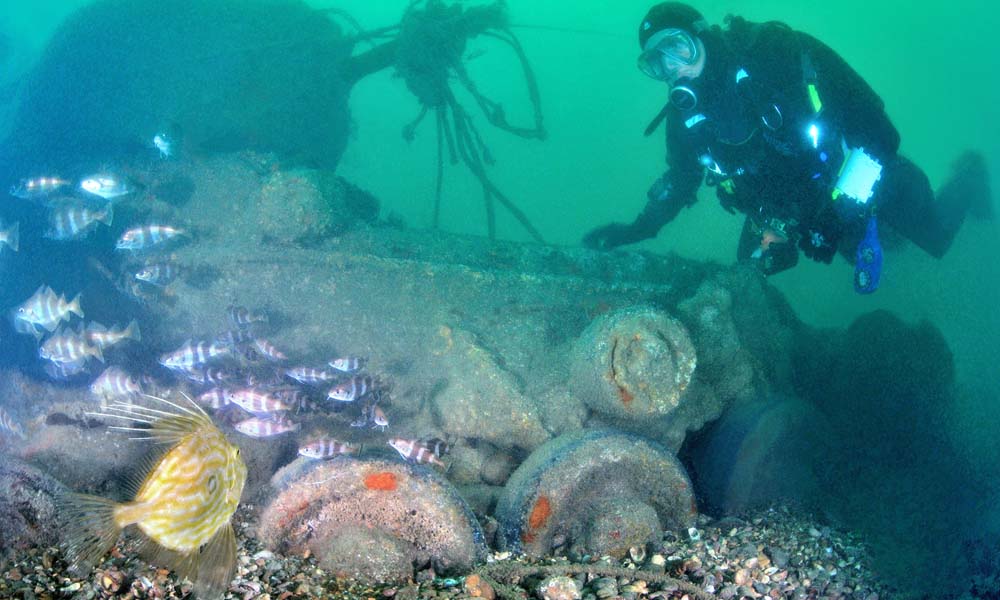
REEF ⬜ WRECK ☑️
GPS: 50°39.468N 001°53.402W (intact tank)
SLACK WATER: On neaps you can dive at any state of the tide, but expect some current. On springs dive 1h 15min before or 5h 15min after high water at Dover.
DISTANCE: 7km from Swanage
DEPTH: approx 15m
SIZE OF WRECK: 5m long
SANK: 4 April 1943
Aeolian Sky
This Greek freighter was fully loaded and en-route to Africa. Early on the morning of 3 November in rough weather she collided with a German ship and came off worst, holed at the bow. She was towed to English waters but the ports of Southampton and Portsmouth refused her access for fear of pollution. The Aeolian Sky could not stay afloat much longer and finally sank. The freighter and its mixed cargo, worth millions of pounds, were all lost to the sea.
The Aeolian Sky is a recent wreck and is Big with a capital B. It certainly makes for a memorable dive and the varied cargo on-board is quite remarkable, from trucks, locomotives to a rumoured million pounds of Seychelles rupees.
The freighter landed on its port side and was later cleared by explosives to a depth of 18m. The wreck is still fairly intact apart from the bow, which has twisted around 90 degrees from the rest of the ship. If this is your first time visiting this monster of a wreck, I would recommend starting at the bow and heading over the superstructure towards the stern, which will give you a good overall picture.
Starting just in front of the bow is your first sight of the unusual cargo, a complete truck chassis sitting upright, complete with tyres still in place revealing plenty of tread, although maybe not road worthy.
Continuing on to the bow, at the base of the wreck are yet more wheels poking out of the debris field. Up on deck are the usual fittings of bollards, cleats and a prominent chain leading down below. As you head around the corner you’ll see the huge starboard anchor firmly lodged inside the hawse covered in jewel anemones and sponges.
To navigate to the rest of the ship you’ll need to drop down and head north-west across the debris field. The obvious cargo along this route seems to consist of huge pipes stacked on top of each other. Eventually, you’ll reach amidships, where you can view the impressive mast lying down. Still attached are various paraphernalia, with a prominent ladder running along it, pulley wheels and rigging. Next, you’ll pass yet more pipes and more tyres before you arrive at the stern. The stern deck is a wide expansive area with a prominent winch with cable still wrapped around. The end of the stern is perhaps the most picturesque area of the ship with the railings and deck fittings mostly still in place. Dropping over the side, you could be forgiven for thinking you’re on the bow as the stern also has an anchor. Head around to view the rudder, but the propeller was salvaged many years ago. Once you’ve dived this wreck you’ll be keen to come back for more and more.
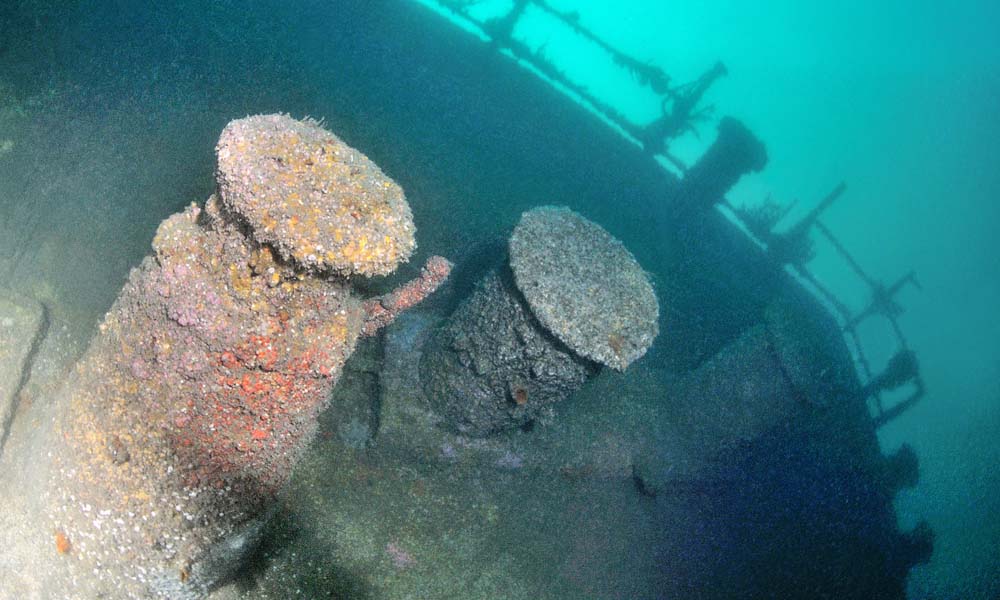
REEF ⬜ WRECK ☑️
GPS: 50°30.541N 00 2°08.420W (bow)
SLACK WATER: Dive 1h before or 5h after high water at Plymouth.
DISTANCE: 19km from Swanage
DEPTH: 22-32m
SIZE OF WRECK: 149m long
SANK: 4 November 1979
This UK Diving article was originally published in SCUBA magazine, Issue 76 March 2018.
Anita is also the author of two beautifully illustrated, authoritative guides to UK shore diving, find out more.

 Author: Anita Sherwood | Posted 29 Aug 2020
Author: Anita Sherwood | Posted 29 Aug 2020



